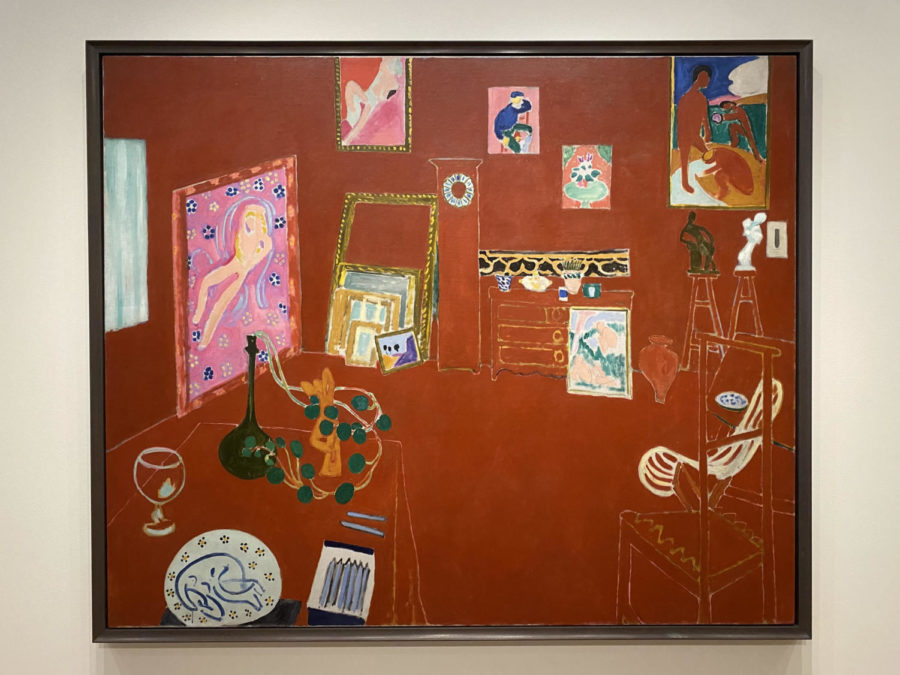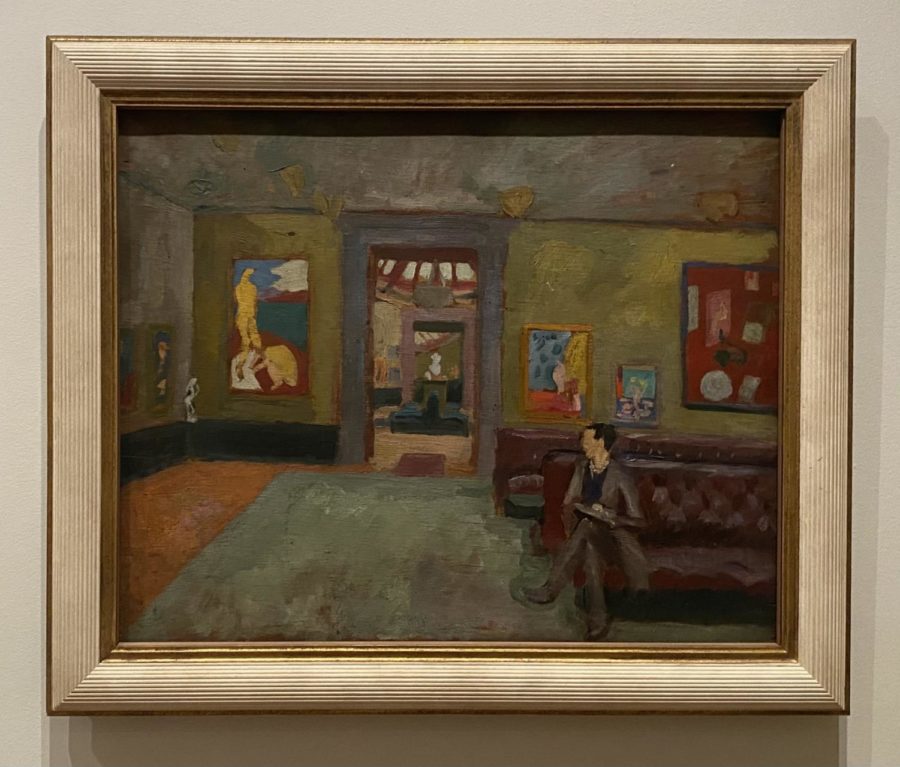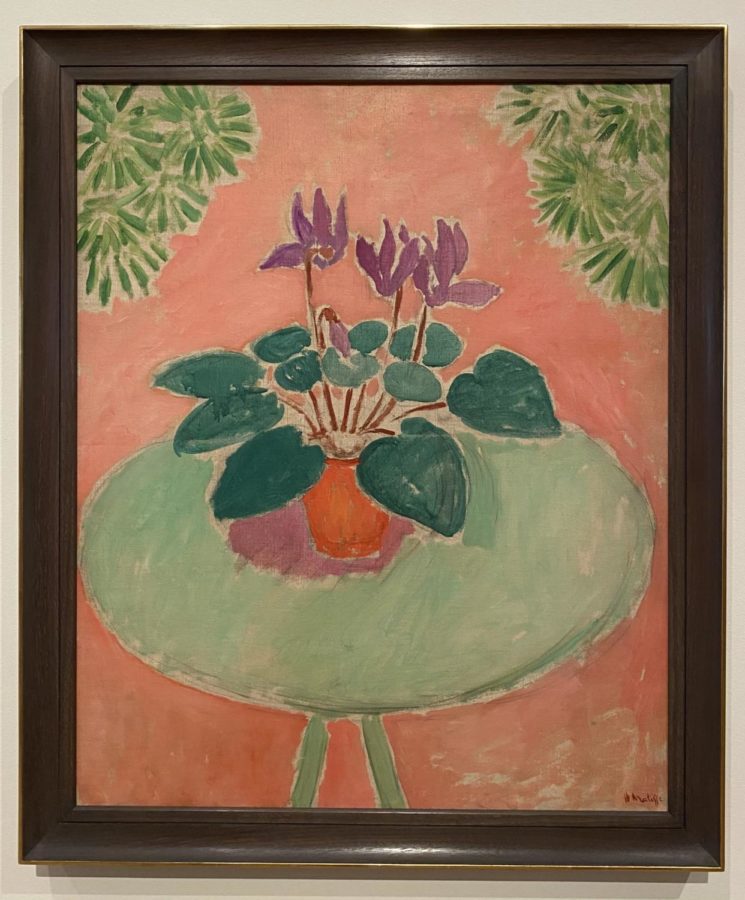Rags to Riches: Matisse’s ‘The Red Studio’ at the MoMA
A fauvist pioneer, Henri Matisse strikes a balance between abstract reveries and realism. The Red Studio brings both styles into the third dimension.
‘The Red Studio’ is the focal point of the MoMA exhibition.
Seldom does a Cinderella story evoke images of fauvist artwork. Although Matisse’s The Red Studio does not lose a shoe, nor does it relentlessly scrub floors, the painting underwent a similar “rags to riches” transformation nonetheless. From The Gargoyle Club – home to London nightlife in the twentieth century – to the world renowned MoMA, The Red Studio tells a fairytale of its own.
The painting was free from the criticism of evil stepsisters, but public opinion was similarly derisive. In accordance was Sergei Ivanovich Shchukin, Matisse’s most notable patron who commissioned The Red Studio. He rejected the finished painting; the reason for his disaccord is still unclear, but the work was thus never sent to Russia. A parallel attitude was present at its first showing in London’s Grafton Galleries.
Opponents argued that the painting evokes images of a poster, classifying it as juvenile. Such humble beginnings are highlighted in Roger Fry’s A Room in the Second Post-Impressionist Exhibition, dated 1912. Fry curated the collection after which the painting received its name, in turn catalyzing the introduction of modern art to England.
While situated in this exhibit, the oeuvre was originally dubbed Panneau Rouge, or Red Panel, referring more so to its style than to its content. It was one of twenty-seven Matisse works on display, others of which are also visible in Fry’s painting. Illustrated observing them is likely Duncan Grant, artist and devotee of Matisse. His face is blurred, and coincides with a dark color scheme to denote a somber tone within A Room in the Second Post-Impressionist Exhibition.
Upon the closing of this showing, The Red Studio traveled to the United States, where it was met with the same contempt. After showings in New York, Chicago, and Boston, the painting had yet to receive a single purchase offer. Overseas, however, a deal was struck. In September of 1927, club owner David Tennant adorned a ballroom at The Gargoyle Club with his acquisition. Attracting artists and aristocrats alike, the hotspot’s popularity was derived from its unique flair, one which The Red Studio only magnified.
When in 1938, Matisse turned down Tennant’s offer to buy back the painting, it was moved within the same city to the Redfern Gallery. It was there that The Red Studio was stationed until 1945, when it was sold to east Manhattan’s Bignou Gallery. Owing to the post-war rise of abstract expressionism in New York, The Red Studio (then titled Studio) was met with newfound popularity. “Following a period of food rationing, paranoia, and weapons that caused never-seen-before destruction,” explained Thibault Kelsohn ’23, “people wanted a way to escape the real world through abstract pieces that were up for interpretation.”
It was in this freshly inaugurated era of appreciation for modern art that Matisse’s work found its final home. The canvas was mounted on the MoMA walls in April of 1949, marking its public debut as The Red Studio. This journey is, from start to finish, depicted in one half of the exhibition. It is biographical in nature, the section filled with paintings from various points in the artist’s life.
One such epoch is marked by his time in Paris, where he attended art school in the 1890s. Although it wasn’t painted until 1916, when Matisse had already fled the city, Studio, Quai Saint-Michel memorializes his Parisian years. The oeuvre is all encompassing; it provides a floor-to-ceiling view of the minuscule apartment, and through a window, one of the metropolis at large.
Each detail tells the story of the workplace, namely a model lying atop a sofa, a half-finished painting of her, and zigzagged floorboards, traditional of Paris. All facets of the abode function cohesively to construct a fauvist, French narrative. Following the sale of the former convent in which he lived, the artist and his family relocated to Issy-les-Moulineaux.
Thus was born a new period of Matisse. His new living space was a custom-built studio, which would later be the subject of The Red Studio. The same space was depicted more immediately after his move in Still Life with Geraniums and The Blue Window.
The former, completed in 1910, is the only still life in which an element of realism is incredibly apparent. Their blue hue aside, the wooden walls are depicted naturalistically, and lie behind a decorated table. On it sit a floral fabric and a flowerpot of geraniums, establishing an ornamental feel to the work.
The Blue Window, finalized three years later, portrays the studio’s exterior. Onlookers observe the scene from a second-floor bedroom, where both the structure and the surrounding trees are visible. Matisse paints the building’s walls as yellow and the forest as blue, both of which are beyond the illustrated table within the bedroom, presented with the same color scheme.
Depicted in the third primary color is the space’s interior in The Red Studio. The panel puts forth a clear image of the workspace, while still following fauvist principles. Its selling point is the element of “art within art” (the featured works constitute the exhibition’s second half).
Amidst the vibrant red that fills the rest of the canvas is, firstly, Nude with White Scarf. Located at the scene’s top left, the 1909 painting features model Loulou Brouty, a long white fabric draped across her body. Her pose was altered a plethora of times throughout the painting process, apparent in the dark, blurred lines around her legs and left arm.
Further evidence of Matisse’s trial and error strategy is visible in Cyclamen, completed 1911. It is a floral still life, hypothesized to have been developed in the greenhouse, as the trademark green table has appeared in other works with the same setting. The painting is thought to have been done quickly, as traces of pencil outlining the cyclamen petals and the table underneath them remain visible.
To the left of Cyclamen is Young Sailor (II). Its subject is a young fisherman, and is one of Matisse’s few male portraits. The boy is said to live in the town of Collioure, where the artist lived from 1905 to 1914. The painting’s flatness, alongside its bright colors, are telltale signs that Matisse was introduced to fauvism – after fauve, or wild animal – during his stay in Collioure.
Just beneath the portrait is Corsica, the Old Mill. It paints a picture of the Frenchman’s first sight of the Mediterranean sea; a resulting excitement is reflected in its visuals. “The hazy image, alongside the potent colors bring the setting to life,” said Griffin Weiss ’24. “It makes it look like somewhere you’d want to be.” Matisse uses light in a calculated way, one which smoothes the view of the olive farm in Ajaccio, Corsica.
In the top right of The Red Studio is Le Luxe (II). It aligns stylistically with European art, in that it pictures the popular image of a group of figures within nature (much like Manet’s Le Déjeuner sur l’herbe, for example). Though the women are darker in complexion in The Red Studio recreation, the original work depicts them as much lighter. It is hypothesized that Matisse made this alteration in order to challenge Eurocentric perceptions of beauty and race, like many avant-garde artists at the time.
Further following the trend of women in greenery is Bathers. Drawing inspiration from Post-Impressionist Paul Cézanne, particularly from his Three Bathers, Matisse chose to leave areas of the canvas blank, completely untouched by any medium. This technique, much like The Red Studio, was originally met with criticism. Matisse’s rise to success was thus certainly not as simple as a “bippity-boppity-boo,” but it is a Cinderella story nonetheless.
“The hazy image, alongside the potent colors bring the setting to life,” said Griffin Weiss ’24. “It makes it look like somewhere you’d want to be.”
Sela Emery is a Copy Chief for 'The Science Survey.' She focuses on art history, covering relevant art pieces and exhibitions with each issue. In addition...



